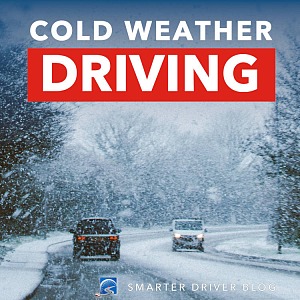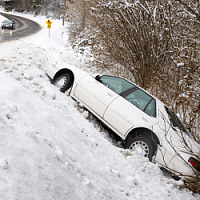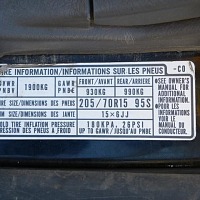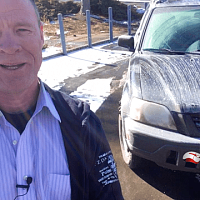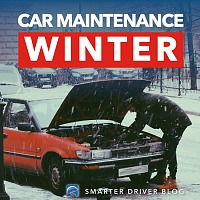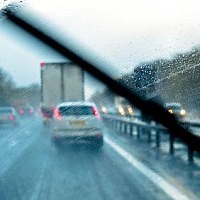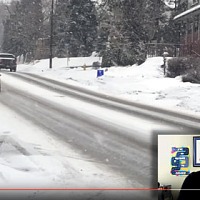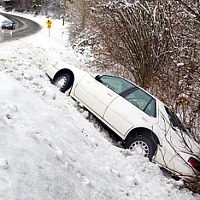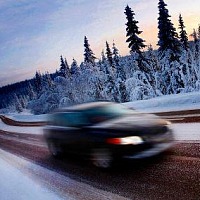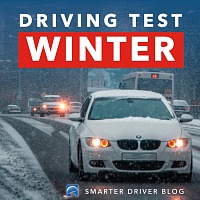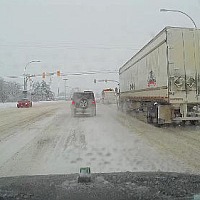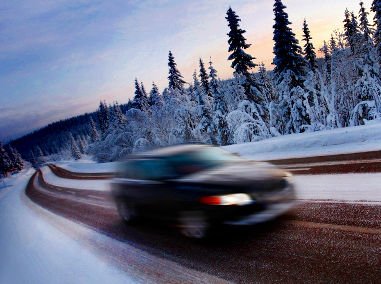Reduce the risk of a crash, ending up in the ditch or getting stuck when driving in snow.
https://www.youtube.com/0TC2KeXF2VU
How to Drive in Deep Snow and on Ice and NOT End Up In the Ditch | Winter Driving Smart
Closed Caption
Introduction
Hi there smart drivers Rick with Smart Drive Test talking to you today about how to drive in the snow.
We've had a good dump snowed in Vernon, British Columbia, Canada here.
And today is a great day to take you out and show you how to drive in the snow.
As well, it's much more slippery today because the temperatures is around freezing 0° degrees Celsius or 32° degrees Fahrenheit and when it's around freezing--take note of that--because know it's going to be more slippery than if the temperature is sub-zero.
I had a comment from Rosas, she was having some difficulty driving at night and in the wintertime when the roadway was snow-covered and finding the roadway.
 And I provided all the information in that night driving video is also applicable to driving when the roads are snow-covered.
And I provided all the information in that night driving video is also applicable to driving when the roads are snow-covered.
I'll put a card up here for you in the corner - have a look at that card and you can find the video on night driving.
So today we have compromised traction.
It's going to be slippery - so the two biggest tools you have in your driving tool box are speed and space management:
- slow down,
- brake early
- and keep a bigger margin of space between you and other traffic and fixed objects on the roadway.
So under ideal conditions in a car or light truck the following distance is two seconds.
Today you probably want to follow at three to five seconds; brake early and make sure there's nobody tailgating you or coming up on you really quickly when you start to slow down because you want to be able to slow down and not have them rear-end you.
And if they are right up on behind you, you might want to abort the turn.
As well, when you go off the main roads on to the minor roads, know that the minor roads aren't going to be plowed and if you get into deep snow it's going to suck you in and it's going to push you around.
So know that you've got to find of a balance between acceleration--so slowing down to maintain steering control-- but at one in the same time, you don't want to slow down so much that you actually get stuck in the deep snow.
We're going to show you how to run through the deep snow and how to keep momentum going and also to not get stuck and lose traction.
As well, make sure your windshield washer fluid is topped up because when you get out on the main highways, there's going to be lots of spray and dirt coming off the roadway from other vehicles.
So those are your main tools and what we're going to do now is hook up the cameras here and go for a drive and show you how to drive in the snow.
Stick around, we'll be right back with that information.
[OPENING CREDITS & MUSIC]
Hi there smart drivers, Rick with Smart Drive Test talking to you today about winter driving and driving in the snow when you can't see the road because it's snow covered.
As well, it is slippery here in Vernon, BC because the temperature is around 0° degrees Celsius--32° degrees Fahrenheit--it's around the freezing point and when it's around the freezing point, it is much more slippery than when the temperature is sub-zero because there's a layer of water on top of the ice and snow that actually lubricates it and makes it more slippery.
And you can see there the ABS (Anti-lock braking System) started to kick in and activate, and actually there's video here on the channel about ABS brakes - have a look at that because if you haven't experienced ABS brakes before and these engage while you're coming up and slowing down you may think that there's something wrong with the vehicle.Because there's grinding and crunching and making all kinds of noise and there's pushback on the pedal.
And actually there isn't anything wrong with the vehicle - those ABS brake responses are normal.
Now you have to be extremely careful driving in weather like this because other people can be unpredictable in the way that they drive.
Now basically we're in town here and it's pretty simple to find where the roadway goes here because you just follow the tracks of the other vehicles.
Now roundabout, you want to be careful with those and make sure that other people are doing what they're supposed to be doing and not tearing through the roundabout.
Because roundabouts are slippery and slick; other vehicles have come through there and the these are braking and sliding and turning on the snow which actually causes it to melt a little bit and create more water which lubricates the snow and ice, thus making it more slippery.
So when you prepare to go out winter driving make sure that you clean your vehicle off completely so that other vehicles can see you and you can see well and clearly when you're driving.
It's important to be able to observe and to see other traffic.
And as well you want to reduce your speed you want to increase your following distance.
Those are two key techniques when you're learning how to drive in the snow.
As well as braking early and stopping back from where you want to stop.
and ensure that your air conditioning is on.
A lot of these newer vehicles, the air conditioning has to be on to draw the moisture out of the cabin of the vehicle, otherwise your windows aren't going to defrost well.
So make sure that your air conditioning is on - that way it'll help to draw the moisture out of the air inside his cabin, particularly the more passengers you have in the vehicle and their exhaling inside the cold weather - there's a lot of moisture in our breath and the more passengers you have in the vehicle the more prone the windows are fogging up.
As well, on days like today make sure that you have your windshield washer fluid topped up, because when you get out on the main highway there's going to be a lot of spray coming off the roadway and whatnot from other vehicles and the fact that they salted the roads and put down sand and whatnot, it's going to make your windshield very dirty and you're going to need a lot of windshield washer fluid to keep the windshield clear.
And make sure that you have good windshield wipers on your vehicle.
If you haven't changed your windshield wipers out for wintertime, today or any other day that you have a lot of snow and ice on the road is a good day to do that.
And I'm on the highway here.
I'm going to show you that you need windshield washer fluid topped up [CHUCKLING] the highway when the temperature is around freezing - 32° degrees Fahrenheit or 0° degrees Celsius, because there is a lot of spray coming off the other vehicles because they have salted the road....
they salted the road and there's sand and whatnot on the road which makes the windshield very muddy.
Getting up to Speed on Highway
That's a dangerous intersection back there.
It comes out onto the highway and when I come out there I turned my four-way flashers on to indicate to other traffic that I was coming out there and I was going slowly.
Now I'm just gonna slow down here.
You can see in the windshield--in the dashcam there--is now fogging over.
And I've got my windshield wipers on.
I'm just getting my speed here, and setting the vehicle on cruise because the road is well salted and the temperature's around freezing.
There's not going to be any ice on the road - it's well-traveled.
When you have these high volume roadways in the wintertime they're going to be well traveled.
And actually, now we're getting back into a bit of snow and slush and I don't want the cruise control on - I just want to work the throttle.
So if you get into any kind of situation or road environment where it's questionable condition of the road, then you don't want to use cruise control.
And this truck is coming over in front of me here and he's got a lot of spray, so I'm going to turn my windshield wipers on in preparation for the amount of spray coming off the back of that truck.
[SIGNALING & PREPARING TO CHANGE LANES TO PASS TRUCK]And actually he or she is doing really well for speed, so I'm just going to hang in behind them here and just leave my windshield wipers on.
And basically you just want to follow the other traffic here on the highway.
Most of the time they're going to stay on the highway, and you can see both shoulders.
It's actually fairly clear driving right now - just with your windshield wipers on and lots of windshield washer fluid, just in case the water coming off the other vehicle isn't enough.
Sometimes you can get into a situation where it just makes the windshield dirty and it never actually gets clean.
I'm operating me defrost controls in the vehicle because the back window is fogged up.
And we're going to get off the main road here and we're gonna go for a little drive in the country and I'll show you some of the techniques you can use in the country, for not only driving in the deeper snow, because some of these back roads won't be plowed yet, because the maintenance crews are simply working on the main roads right now.
As Your Get Farther Off the Main Roads, the More Snow
And as they get to farther and farther away onto the secondary roads, just know that that's not their priority right now.
The priority is to clean the most traveled roads to make them safe for the most number of vehicles.
So they'll get into the backcountry later.
So that's where we're gonna head.
You can see here on the road there that there is tons and tons of salt sand on the roadways and there's tons of spray coming off the other vehicles here.
And we communicate to other traffic well in advance that we're getting off the road, checking your mirrors behind you for following traffic.
And you can see that there's plenty of snow on the off ramp.
So you just want to keep the vehicle in a straight line - that way you're not going to lose control if it's slippery.
And slow right down to where you want to turn here.
You can see, I'm in the deep snow here and it's actually pulling the vehicle around quite a bit.
And in the wintertime, if you've got an automatic vehicle, you're not going to have the advantage of what i just did there.
What I did was I put it in third gear and I was going too slow for third gear, but I had lots of traction, lots of torque on the tires, so therefore the snow didn't pull me around as much as if I had a vehicle equipped with an automatic transmission.
You just don't have that kind of control with an automatic transmission in the snow.
But there's another video on the channel here that shows you how to do a bit more control with an automatic transmission in the wintertime.
I'll put a link up here for you in the corners to have a look at that and that'll help you out in the snow with an automatic transmission.
And you can see that the windshield is...there's lots of dirt salt snow and whatnot on the windshield here.
I just have to put some windshield washer fluid on it.
Higher Gear...Better Traction
And when you're in a manual transmission - I'm in fifth gear here and you can see that I'm doing less than 60 kilometers an hour - less than 40 miles an hour.
The reason I have the transmission in 5th gear is because I've got a lot more traction because the wheels are less apt to spin at a high gear.
And I've got lots of torque there.
And that's helping with my traction.
And you can see I'm using lots of windshield washer fluid with this day.
With it being very mild, it's gone up above freezing - it's probably 1° or 2° degrees (34°-36°F) now, and the snow is apt to melt.
So we just meet other traffic - we just try to move over to the right as far as possible.
Obviously for most of you that drive on the left hand side of the road you're not going to be experiencing snow as we have right now.
On occasion you'll have snow and ice in Australia or in the UK (United Kingdom) - once in awhile you do get it, but not very often for the most part.
this road is not too bad.
It is snow-covered, and it is fairly slick.
We're going to find another road here for you that is going to be less plowed.
And as long as you keep the vehicle in a straight line you're not going to lose control; you just work the throttle and just keep the vehicle in a straight line.
When you do around curves, corners and turns - just nice and easy on the steering wheel.
And again, as I talked about previously, you can use chop steering, which is just turning the steering wheel, and then bringing it back to straight, turn the steering wheel a little bit, bring it back to straight.
That way it's going to regain traction with the steer tires when you're turning corners.
That is one of the techniques that you can use to turn corners in compromised conditions.
And again, when you're getting over into that deep snow there, you have to watch that because you could potentially get pulled into that deep snow.
So try and keep away from it when you have other vehicles that you're passing as we just did there.
When there's oncoming traffic and you have to get over.
And again, whenever you're turning watch the traffic behind you.
You can see right now that I had to slow right down there because it's pretty slick here on that turn your.
Even with my steel studded snow tires it is very slippery.
So keep that in mind when the temperature is around 0°C (32°F) And we're going up hill here and you can see that the truck is working pretty hard.
And again, you don't want to be getting going too fast; they have sanded this road here but there's a fair bit of snow on the road still.
And you want to be looking as far down the road you can to see oncoming traffic, because you may have to get over and actually stop.
Because you don't want to get over into that deep snow at all.
And again, we just work the throttle as we're coming around the corner here and we have a big 18-wheeler coming down the hill, so we're going to try and give that rig as much room as we can here.
And just nice and easy in the snow here.
I need to keep power to it because if you're into that deep snow and you start losing traction, and you're going uphill - if you lose that momentum, that's when you're going to get stuck.
Keep the MomentumSo you gotta try and keep the vehicle going.
So there's kind of a medium there: you gotta find of working the throttle and keeping the vehicle moving.
Because as long as you keep the vehicle moving, it's less likely that you're gonna get stuck.
If you take your foot off the throttle, you're actually going to get stuck because the vehicle just come to a stop and you won't get enough traction to get it going.
so I'm coming up over the top of the hill here and I shifted into a higher gear now to try and get some of that traction back.
And again I got another vehicle coming here and I'm just trying to move over to the right as far as I can here to keep the vehicle moving.
And I'm looking for side road here to get into some of the deeper snow.
A road that probably hasn't been plowed here.
And there's a street right there.
And again when you're braking, you want to try and keep the vehicle into a straight line because you're going to have more control when you're braking in a straight line then if you're trying to turn in the wintertime.
You have to have separate use of the primary controls.
You are not going to be able to steer and brake at the same time; otherwise the vehicle--if you're lucky--is just going to continue in a straight line.
And again, when you come up and it's compromised conditions like this and it's slippery, make sure you look behind you, make sure there are no other vehicles coming up behind you because it's very slick.
So just nice easy pressure on the throttle - try and maintain traction as you're going forward.
And again, good quality snow tires, good quality tires-- M + S or snowflake rated tires--are going to help you with all of this.
I've got a person up here on a tractor plowing the driveway, And again, you want to give these people a wide berth because they're backing up with the plow and they're not really paying attention to traffic as much as they should be.
So you always want to give them a wide berth - slow right down when you're going past them because that way you are reducing the risk of a crash with them.
[TRANSITION] So we're on a back road here in a bit of deep snow and again you just want to go slow you just want to take your time here.
You don't want to be giving it a lot of throttle because the more throttle you give it, you're going to lose traction - over-acceleration is going to cause you to lose traction.
Again you want to brake early because you don't want to actually get up to where you need to stop and find out that you don't have any traction to be able to stop the vehicle.
So always brake early, bring the vehicle to a crawl and then creep up to where you actually want to stop.
And when you're on these back suburban roads it's important that you go slow because in the wintertime there's kids out in these residential areas and they're playing street hockey, and those types of things or doing other winter activities.
So you want to go slow in these residential areas because you have compromised traction, and the roads aren't well plowed.
And the path on the roadway is not very wide and you want to scan well and scan all the way across on both sides of the road and make sure that there are no other road users or other vehicles on the roadway.
Conclusion
Quick review of winter driving: make sure you clean your vehicle off completely before you depart so you can see and be seen by other vehicles.
Clean all the glass and lights off before you depart.
As well, if the temperature's around freezing, not only know that it's gonna be slippery, but on the main roads there's going to be a lot of spray coming off the other vehicles because they're going to be well salted and sanded.
And that melting snow and ice is going to create water that's going to be very dirty because of the sand that they put down on the roadway.
And it's going to create spray ,so make sure you have your windshield washer fluid topped up as well.
In preparation for winter driving make sure you get good tires on your vehicle, either M + S--mud & snow tires or tires with the snowflake on them, or good quality snow tires on your vehicle.
As well, if the windshield wipers need to be replaced, change those out as well so that you can see when you're using your windshield washer fluid.
Stop back from where you actually want to stop and then creep up because you might find that when you get up to the intersection or wherever else you need to stop you may not stop because you're going to hit a slippery patch of the roadway.
So stop back, slow down back actually, from where you actually want to stop and then creep up to where you want to stop.
Work to keep the vehicle in a straight line when you're braking, especially when it's slippery, that way you're less likely to lose control.
Know that on turns you're not going to be able to turn and brake at the same time.
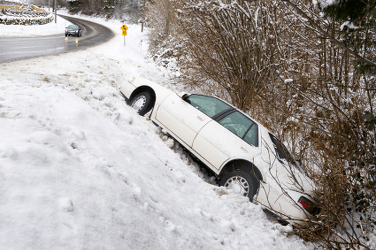 Those two primary controls are going to be separate actions, so slow right down and then turn.
Those two primary controls are going to be separate actions, so slow right down and then turn.
And actually, when you turn-- especially driving a front-wheel drive vehicle--you might need to give it a bit of throttle.
One last point: if you're on roads that aren't plowed and there's shoulders where maintenance crews have banked up the snow, and you're passing another vehicle-- there's oncoming traffic coming--you need to get over - make sure you stay out of that deep snow.
Now if you do end up driving in deep snow, make sure you keep the momentum going on the vehicle because of you stop, for whatever reason, you may not get that vehicle going again because now you're stuck.
So if you're driving in deep snow, keep the momentum going.
If you've got good quality tires on you should be able to do that.
Now if you have any conditions in the wintertime that are questionable whatsoever don't use cruise control on slippery conditions.
Keep your foot on the throttle and just work the throttle.
Give yourself lots of room to brake and brake early.
And as well when you're braking on slippery conditions, make sure that you check the mirrors and check the traffic behind you because you don't want to be slowing down or stopping and have a vehicle piling into the backend of you because they're tailgating you and following too close and they can't get their vehicle stopped.
So those are some good tips for winter driving that will keep you safe, and again give yourself more time.
This is probably the most important tip...
give yourself more time; budget more time because it is going to take you more time to get to where you need to go in the wintertime with less than ideal driving conditions.
Question for my smart drivers:
Do you have any driving tips for new drivers learning to drive in the snow?
Leave a comment down in the comment section there - all that helps out the new drivers learning how to drive in wintertime.
I'm Rick with Smart Drive Test.
Thanks so much for watching.
If you like what you see here share, subscribe, leave a comment down in the comment section.
As well, hit that thumbs up button.
Check out all the videos here on the channel if you're working towards getting your license or starting your career as a bus or truck driver.
Lots of great information here; as well head or website good information over there and online courses that you can purchase.
Stick around to the end of the video - funny bits, and links to the other videos and to my website.
Thanks again for watching.
Good luck on your road test.
And remember, pick the best answer not necessarily the right answer.
Have a great day.
Blooper
Bye now.
[DAUGHTER] Can we talk now? Yes, we're almost done - we're going to the conclusion.
[DAUGHTER[ When can we say hi? Just a minute [SON] Daddy - after we finish the video can we....

